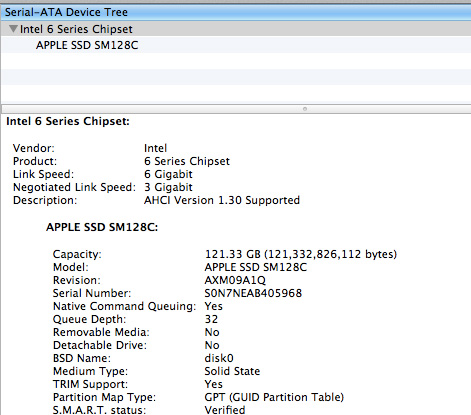The 2011 MacBook Air (11 & 13-inch): Thoroughly Reviewed
by Anand Lal Shimpi on July 28, 2011 3:25 AM EST- Posted in
- Apple
- Mac
- Intel
- Sandy Bridge
- MacBook Air
- Laptops
SSD Performance
Last year's MacBook Air was the first Mac to ship without a mechanical hard drive or an option to install one. Using a custom form factor, Apple partnered with Toshiba (and later Samsung) to build value SSDs for the MacBook Air line.
Although Apple has tested solutions from Intel, Marvell and SandForce, to date it hasn't opted to ship any of them to market. Toshiba and Samsung offer much better pricing and don't mind being silent members of the supply chain. There are also reliability benefits. While Toshiba and Samsung may not perform as well as the aforementioned controller makers, they've definitely had fewer issues.
My 13 had a Toshiba based drive while my 11 had a Samsung drive. You can tell what controller you have by looking at the model string in a System Report from your machine. The SM prefix indicates a Samsung drive while the TS indicates Toshiba:

Both controllers are limited to 3Gbps operation (neither company has released a 6Gbps controller) but performance does vary pretty significantly between the two:
| 2011 MacBook Air SSD Performance Comparison | ||||||
| 4KB Random Read (QD3) | 4KB Write Read (8GB LBA Space QD3) | 128KB Sequential Write | 128KB Sequential Read | |||
| 13-inch MacBook Air (Mid 2011) - Toshiba SSD | 18 MB/s | 1.65 MB/s | 204.2 MB/s | 189.5 MB/s | ||
| 11-inch MacBook Air (Mid 2011) - Samsung SSD | 44.6 MB/s | 27.2 MB/s | 258.0 MB/s | 234.4 MB/s | ||
| 11-inch MacBook Air (Late 2010) - Toshiba SSD | 31.1 MB/s | 2.49 MB/s | 147.0 MB/s | 113.0 MB/s | ||
The Samsung drive has much better random and sequential performance, maxing out the 3Gbps interface when it comes to sequential reads.
In regular use I doubt you'd notice a huge performance difference between the two, but if you want the fastest drive you want the Samsung. Compared to last year's MacBook Air (Toshiba) you get a huge boost in sequential read/write performance.
Both drives support TRIM under OS X.
WiFi
Unlike other members of the 2011 Mac family, the MacBook Air retains a WLAN stack with 2 receive and 2 transmit antennas via the Broadcom BCM4322. The WLAN solution in the Air is capable of up to two simultaneous spatial streams, topping out at 270Mbps.

In practice this results in peak performance over 802.11n at around 128.8Mbps. Testing at the same distance I tested the MacBook Pro and iMac at, the results drop to 116.8Mbps.
| 802.11n Network Performance Comparison | ||||||
| 27-inch iMac (Mid 2011) | 15-inch MacBook Pro (Early 2011) | 13-inch MacBook Air (Mid 2011) | 11-inch MacBook Air (Mid 2011) | |||
| Peak Network Transfer Speed | 150Mbps | 133Mbps | 116.8Mbps | 116.8Mbps | ||
The new Air also supports Bluetooth Low Energy, although without any Bluetooth LE devices on hand I was unable to test the feature.










103 Comments
View All Comments
ifyouwanto - Tuesday, August 2, 2011 - link
Hi Anandtech,In your review of the 2010 11" model you commented that the hinge felt a bit loose or weak. Wondering if it is any different on this years model?
Thanks
slatanek - Saturday, September 10, 2011 - link
i have a 13 inch Macbook air i5 2011 and its hinge is rock solid. it feels very assuring :-)cheers
Wskcondor - Thursday, October 13, 2011 - link
I read this review and also the 2011 iMac review. I have a couple of questions someone with the hardware in front of them or with more knowledge may be able to answer...My idea is to travel with the 2011 Macbook Air, with the 1.8G i7 upgrade and 256G SSD.
-I like the Thunderbolt display idea of a dock, because when I am "at home" I do a lot on the computer at the desk and I store a lot externally from the Air (movies, music, photos) and also still use an optical drive regularly. In effect, with a T-Bolt display, all of these things would be hanging off the display.
Then I thought: why couldn't I buy a 2011 iMac and use it as a "display/dock station" when at home?
1) Could I boot the 11" Air into TBolt target drive mode and then BOOT the iMac from the Air's drive, so all the "local changes" would be on the drive I take away on travel with me? The processor would be an i7 also in the iMac. BUT the configuration would be different, of course.
-will this jack up settings in the Air's hard drive when I disconnect and reboot the Air from it's internal processor?
-will this be too slow a configuration because the TBolt target drive mode has such slow throughput that the iMac will crawl along?
-Can I even boot an iMac off the Air's TBolt target SSD drive?
2) Can the iMac become a "Thunderbolt monitor" with drives, ports, etc if I boot the iMac into TBolt target mode? Or would it just be a blue screen with drives and ports, extending my Air's ports, but not acting as an external monitor?
Questions.
thanks to anyone who knows.
Wskcondor